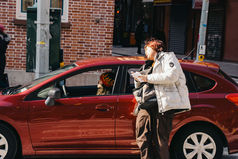Shinya Lin
New Music City (2024-25) in M a n h a t t a n C h i n a t o w n
New Music City draws inspiration from the concept of Ubiquitous Music, structuring routes informed by Chinatown's history of protest and resilience. This project guides performers through historically significant sites where demonstrations once took place, carrying forward this heritage and fulfilling these locations as living, modern soundscapes. Performers will carry music both intricately and spontaneously, while audiences, following a guided map, will navigate the area through improvised paths with suggested sites, encountering performances in pure aleatory. Functioning as a silent protest, this sonic interpenetration of daily life amplifies the voices of heritage, reimagining the city's auditory landscape through intrusive sounds-music, in this case. Ultimately, the project explores how sound shapes our perception of place and history, fostering a deeper awareness of auditory experiences as integral to culture and daily life.
New York City's Chinatown has long been a battleground for resistance and survival, where generations of Chinese immigrants have mobilized against discrimination, displacement, and economic injustice. New Music City highlights this cultural heritage of struggle and resilience through eight pieces dedicated to historical events that have shaped the community. These include The Center of Justice in New York City (for Campaign for Economic Justice at Foley Square, 1992), Silent People (for Police Brutality Protest for Peter Yew, 1975), No One Came (for March on 5th Precinct), A Lost Era of "Unvoiced Documentary" (for old sites from Chinatown address books), The Souvenir Mania - "A Mecca of Tourism" (for overpopulated gift shops taking over cultural heritage), Out on the Street (for Protest Against the Chinatown Jail, 1982), Cobra (for Equal Employment Protest at Confucius Plaza, 1975), and The Chinatown Bosses (for Garment Workers' Strike, 1982). By tracing these moments of exclusionary policies, labor exploitation, and systemic violence, the project reflects on Chinatown's past while addressing present challenges, such as the growing presence of souvenir shops and the forced relocation of long-standing businesses and residents— ultimately raising the question - where do we go next?
1 - - - - - - Spectation 02/23/25 was developed and presented as part of Shinya's artist-in-residency at the Museum of Chinese in America
Performers
Ivan Chen, Celine Kang, Kevin Sun, Yuhan Su, Roger Lin, Evan
Palmer, Borbo, Weiyang Ding, Qianyi Shi, Yu-Cheng Huang,
Ethan Cohn, Aaron Pond, Alex Yoo, Arjan Singh, Iseul Kim
Production Team
Qiujiang Levi Lu, MAYSUN, Lingyuan Yang

The Eight Pieces
The Center of Justice in New York City (2024)
- for Campaign for Economic Justice at Foley Square in 1992
The 1992 Campaign for Economic Justice at Foley Square was a
pivotal moment in the fight for fair labor practices and economic
equity in New York City. Organized by the Chinatown-based labor
and immigrant rights groups, the campaign brought together a
diverse coalition of activists, including garment workers, community
members, and political leaders, to demand better working conditions,
fair wages, and an end to exploitative practices in the city's garment
industry. The protest at Foley Square highlighted the intersection of
labor, race, and economic justice, drawing attention to the systemic
inequalities faced by Chinese immigrant workers and their ongoing
struggle for dignity and fairness in the worktorce.
Silent People (2024)
- for Peter Yew/Police Brutality Protest 1975
The Peter Yew/Police Brutality Protest of 1975 was ignited by a tragic
incident that morning. Peter Yew, a Chinese immigrant living in New
York City's Chinatown, was involved in a confrontation with police
officers after he was stopped by an officer for allegedly being intoxi-
cated. Despite being sober, Yew was struck by the officers, who
violently beat him while he was still on the ground, leaving him seri-
ously injured. The incident occurred in full public view, sparking
outrage throughout Chinatown. The community, already frustrated by
ongoing police harassment and racial discrimination, rallied together
in response. Yew's beating became a flashpoint for one of the largest
Asian American protests in U.S. history, with demonstrators demand-
ing justice for Yew and calling attention to the systemic police brutali-
ty and racism faced by Asian American communities. The protest
marked a pivotal moment in the fight for civil rights and equality for
Asian Americans.
The Souvenir Mania - 'A Mecca of Tourism' (2025)
- for overpopulated gift shops taking over cultural heritage
In an era where skyrocketing rent has become a societal crisis, many
long-standing local businesses have been forced to close. According
to Terry, a café owner who has been in business for over 15 years in
Manhattan's Chinatown, many business owners can no longer afford
the rising rental fees when it comes time for lease renewal. What we
are witnessing is the slow transformation of Manhattan's Chinatown,
as it becomes increasingly overrun by generic New York souvenir
shops, competing with counterfeit sellers to attract tourists. Mean-
while, Chinatown communities have been steadily moving beyond
Manhattan, as seen in the rapid growth of Brooklyn's 8th Avenue
Chinatown. Where are we headed next?
Out on the Street (2025)
- for Protest Against the Chinatown Jail, 1982
The 1982 protest against the proposed Chinatown jail marked a
significant moment of resistance, as community members and activ-
ists rallied against the construction of the Manhattan Detention Com-
plex, also known as "The Tombs." Despite the strong opposition, the
detention center was ultimately built, serving as a symbol of the
neighborhood's struggles with displacement and systemic neglect.
Fast forward to today, and the fight is far from over. The city's current
plan to replace The Tombs with a new, larger "mega jail" has sparked
renewed protests in Chinatown. Activists argue that this new facility
will continue the legacy of marginalizing the community, further
threatening its cultural integrity and survival. The ongoing protests
are a direct continuation of Chinatown's long history of fighting for its
rights and resisting harmful city policies.
No One Came (2024)
- for March on 5th Precinct
The March on the 5th Precinct in Manhattan's Chinatown was a pow-
erful response to a series of incidents that reflected deep-rooted
tensions between the community and law enforcement. One key
event was the harassment of students from Transfiguration School, a
Catholic school located in the heart of Chinatown. These students
were frequently targeted by police while gathered at Columbus Park,
a common gathering place for the local community. In one notable
incident, the students were harassed and detained by officers, which
led to widespread outrage. In protest, the school's administration and
students, alongside other community members, organized a march
to the 5th Precinct, demanding an end to racial profiling and police
mistreatment.
Additionally, another controversial case involved four men who were
parked in Chatham Square, a known intersection in Chinatown. A
woman falsely reported to the police that the men were armed and
dangerous. In response, police arrived and conducted a search of the
car, even though no weapons were found. This incident, based on an
unfounded and discriminatory tip, further fueled the sense of injustice
in the community. These events, combined with others, underscored
the constant fear of police harassment faced by Chinatown residents,
especially in the 1980s and 1990s. The march on the 5th Precinct was
not only a protest against individual acts of discrimination but also a
larger call for systemic change, highlighting the ongoing struggle for
dignity, respect, and equal treatment within the community.
A Lost Era of 'Unoviced Documentary' (2024)
- for old sites from Chinatown address books
There used to be thick address books listing the contact information
and addresses of most local businesses and communities, primarily
in Manhattan's Chinatown and across various states. Updated annu-
ally or biannually, these directories served as a vital resource, keeping
the community connected. Without needing to know English, individ-
uals could navigate and access essential services, fostering a hidden
culture of mutual support and collective growth. While these contact
books no longer exist publicly, and many businesses have changed
or evolved into something new, the people within the community
continue to strive and persevere.
Cobra (2025)
- for Equal Employment Protest at Confucius Plaza in 1975
The 1975 Equal Employment Protest at Confucius Plaza was a pivotal
moment in the fight against discrimination in Manhattan's China-
town. As the largest residential complex in the neighborhood was
being constructed, local activists and community members rallied
against the exclusion of Chinese American workers from the build-
ing's unionized construction jobs. Organized by the Asian Americans
for Equal Employment (AAFEE), the protest drew hundreds of dem-
onstrators demanding fair hiring practices. After sustained pressure
and picketing, the movement succeeded in securing job opportuni-
ties for Chinese American workers, marking a significant victory
against racial discrimination and paving the way for greater labor
inclusion in the city.
The Chinatown Bosses (2025)
- for Garment Workers Strike in 1982
The 1982 Garment Workers' Strike in Manhattan's Chinatown was a
landmark moment in labor history, led by thousands of Chinese
immigrant women demanding fair wages and better working condi-
tions. At a time when the garment industry was a vital source of
employment for Chinatown's community, factory owners attempted
to cut benefits and maintain exploitative conditions. In response, an
estimated 20,000 garment workers, predominantly women, walked
off the job, flooding the streets with chants and picket signs. Their
collective action forced factory owners to negotiate, ultimately secur-
ing better contracts and demonstrating the power of organized labor.
The strike remains a pivotal example of Chinatown's resilience and
the fight for economic justice.












